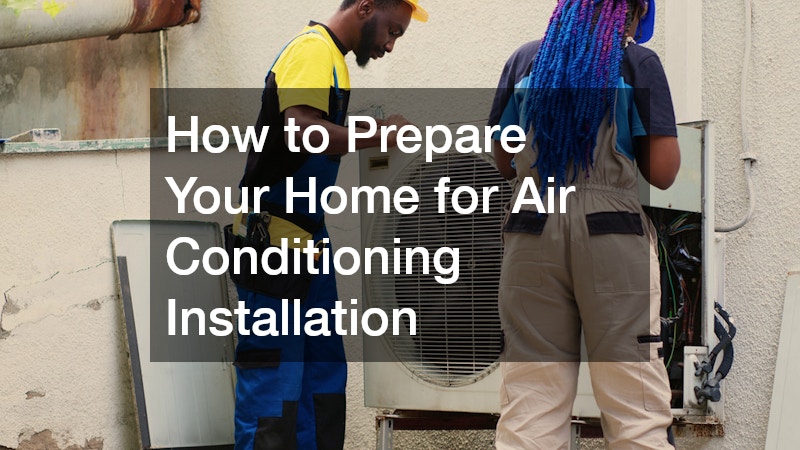Installing a new air conditioning system can significantly improve comfort levels in your home. While a licensed technician will handle the actual installation process, there are several things homeowners can do to ensure everything runs smoothly.
Proper preparation not only helps the installer work efficiently but can also prevent unnecessary delays or complications. Whether you’re upgrading an existing system or installing one for the first time, the following tips will help get your home ready for air conditioning installation.
Clear Access Points & Pathways
Installers need unobstructed access to both the indoor and outdoor units. Before installation day, check that all doors, hallways and access points are clear of furniture, rugs or household clutter.
This allows technicians to bring equipment inside quickly and safely.
If you’re having a split system installed, make sure the area where the indoor unit will go is easily accessible. Move furniture or wall décor out of the way and allow for plenty of space around the designated area. For ducted systems, ceiling access may be required, so check that your manhole is not blocked or obstructed.
Outside, clear any debris, garden tools or vegetation that might hinder access to where the condenser unit will be placed. A tidy work area helps the installation team do their job efficiently without the risk of damaging your property.
Secure Pets & Inform Family Members
Air conditioning installation involves tools, open doors and possible hazards. To keep everyone safe, it’s important to plan ahead if you have pets or young children. Confine animals to a separate room or ask a friend to look after them during the appointment. This reduces the risk of injury to your pets or distractions for the installers.
Let all household members know the date and time of installation. This ensures everyone is aware of the work being carried out and avoids anyone unknowingly getting in the way. If someone in the household works from home, they may want to schedule meetings away from noisy areas or take the opportunity to work offsite that day.
Discuss System Placement & Requirements
Before installation day, speak with your technician about where the indoor and outdoor units will be placed. A good installer will recommend the most efficient and practical locations based on your home’s layout, insulation and ventilation. However, it’s still a good idea to discuss your preferences and ask any questions you may have.
Consider whether the proposed locations for the units might interfere with daily living or aesthetic preferences. For example, the outdoor unit should be placed in a well-ventilated spot, away from direct sunlight and not too close to bedroom windows due to potential noise. Indoors, make sure the unit won’t be positioned above electronic equipment or where airflow will be blocked by furniture.
Also, ensure that your current electrical system meets the requirements of the new system. In some cases, upgrades or additional circuits may be necessary. Your installer can help identify this, but it’s worth checking in advance to avoid last-minute surprises.
Remove Fragile Items & Cover Furnishings
Even the most careful technicians can’t prevent all dust or movement during installation. To protect your belongings, remove fragile or valuable items from the work area. Wrap or cover furniture, electronics or flooring near the installation zone with dust sheets or drop cloths.
If installation requires ceiling access or drilling into walls, be prepared for some noise and minor mess. Professional teams usually clean up after themselves, but taking precautions beforehand ensures your home stays tidy and damage-free.
Check Ventilation & Airflow Zones
Good airflow is crucial to the performance of any air conditioning system. Before the installation takes place, assess your home’s airflow zones. Ensure that vents, ducts or fan outlets are not blocked by furniture, curtains or bulky items. Your technician will likely adjust vent positioning or make recommendations, but having clear zones ahead of time supports a better outcome.
You should also consider sealing any obvious air leaks in doors or windows. Drafty areas can undermine the efficiency of your new system and lead to increased running costs. Simple sealing strips or door snakes can make a big difference to indoor climate control.
Plan for a Short Power Interruption
During installation, your technician may need to briefly shut off power to complete the wiring safely. This can affect household appliances, internet connections and security systems. Make sure any important data is saved, switch off sensitive electronics and let family members know there may be a temporary outage.
This is also a good time to ask about system testing, thermostat setup and how to operate the unit efficiently. Understanding your system from day one helps ensure you’re getting the most out of your investment.
Preparing your home for air conditioning installation doesn’t have to be complicated. With a bit of planning, you can ensure the process is efficient, safe and stress-free for both you and the technician.
By clearing pathways, securing pets, protecting furnishings and understanding system requirements, you’re setting the foundation for a successful installation and long-term comfort. Once complete, your new system will help keep your home cool and enjoyable.
.




